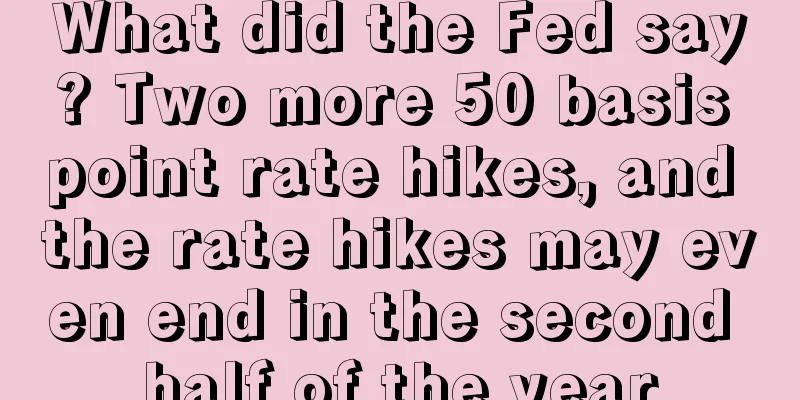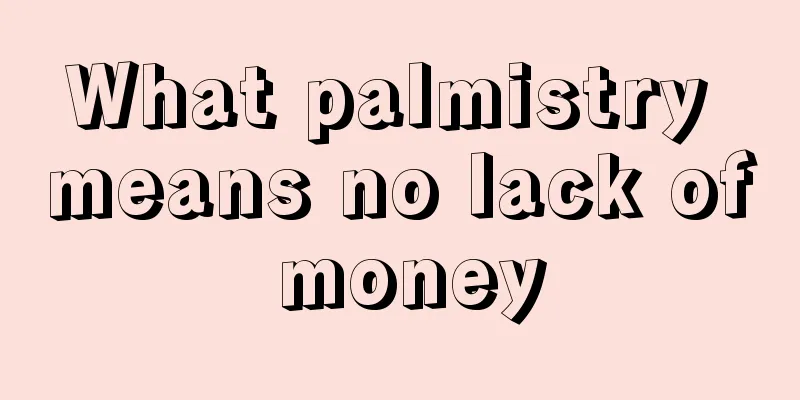What did the Fed say? Two more 50 basis point rate hikes, and the rate hikes may even end in the second half of the year

|
The minutes of the meeting released on Wednesday, Eastern Time, showed that at the Federal Reserve's monetary policy meeting earlier this month, Fed policymakers emphasized the need to raise interest rates quickly to curb inflation, which may exceed market expectations, and believed that the two most recent meetings in June and July this year would need to raise interest rates by 50 basis points. The Fed's move to raise expectations for recent important inflation indicators has also led to speculation that this round of interest rate hikes may end this year or in the second half of the year. When discussing the outlook for the U.S. economy, the minutes mentioned that Fed officials believed that monetary policy might have to exceed the neutral level that is neither supportive nor restrictive. The minutes said: "Participants agreed that uncertainty about the economic outlook was high and that decisions should be data-driven, focused on returning inflation to the (Federal Reserve Monetary Policy) Committee's objective of 2%, while maintaining strong labor market conditions. At this point, participants judged that it was critical to quickly shift to a more neutral monetary policy stance. They also noted that a restrictive policy stance could become appropriate given the changing economic outlook and risks to the outlook." In terms of monetary policy decisions, the minutes mentioned Participants agreed that the Fed should "quickly move the stance of monetary policy toward neutral" by raising interest rates and shrinking its balance sheet. Most participants judged that it would probably be appropriate to raise the interest rate by 50 basis points each time over the next couple of meetings. Several participants believed that the Fed’s “previous communications have helped shift market expectations about the policy outlook to be more consistent with the Fed’s assessment and have contributed to the tightening of financial conditions.” Some commentators believe that this minutes confirms that senior Fed officials believe that it is necessary to raise interest rates by 50 basis points in both June and July, as in this month. Other commentators say that the minutes imply that the Fed is open to reconsidering aggressive rate hikes. Eric Merlis, managing director of Citigroup Global Markets, commented that he saw from the minutes that the Fed admitted that they would not rashly go down one path and that they acknowledged that the situation could change. Randy Frederick, managing director of trading and derivatives at Charles Schwab, believes that the minutes were almost a month ago and there has been a lot of time for the market to change in the meantime, and it will not really affect any future situations. Staff raised PCE inflation expectations. This cycle may end with three more 50 basis point rate hikes. The minutes show that at the meeting earlier this month, the Fed staff updated their expectations for personal consumption expenditures (PCE) inflation. They slightly raised their expectations for PCE price inflation in the second half of this year and next year in response to the slow easing of supply-side constraints in the first half of this year. This supply-side situation has led to higher expected import prices. They also believe that rising wages will put more upward pressure on service prices than previously expected. The results of the adjustment are: The overall PCE price inflation rate is expected to be 4.3% this year. As the expected slowdown in cumulative demand and easing of supply constraints will reduce the supply and demand imbalance in the economy, PCE price inflation is expected to fall back to 2.5% next year and in 2023, and to 2.1% in 2024. Commentators believe that the above adjustment in expectations is of great significance. Vincent Cignarella, a strategist at Bloomberg, believes that although most Fed officials believe that they will continue to raise interest rates by 50 basis points several times in the future, and that continued aggressive actions will give the Fed the flexibility to shift when needed, tightening may not last for a long time. Cignarell estimates that if the above PCE expectations are accurate, it implies that if there are three more 50 basis point rate hikes, the Fed will end its current monetary tightening cycle, paving the way for a major risk rebound in the second half of this year. Before the release of the meeting minutes, Wall Street News mentioned in an article earlier on Wednesday that the current interest rate market's expectations for the Fed's rate hike have cooled, while expectations for the Fed's rate cut after the rate hike have heated up. Since the Fed's meeting earlier this month, the market's expectations for the Fed's September rate hike have dropped sharply, from 80% to less than 40%. JPMorgan Chase strategists believe that September may be a key point in the Fed's turn, because three more CPIs will be released by then to prove whether inflation is really slowing down as Fed Chairman Powell believes is necessary. Many people believe that it may be appropriate to sell off agency MBS in the future. Balance sheet reduction may have an impact on the financial market environment. The Federal Reserve meeting earlier this month decided to raise interest rates by 50 basis points for the first time in 22 years. After the meeting, it also disclosed a roadmap for balance sheet reduction, which will begin on June 1. Initially, the maximum monthly reduction will be a total of US$47.5 billion, including US$30 billion in U.S. Treasury bonds and US$17.5 billion in agency mortgage-backed securities (MBS). Three months later, the monthly reduction cap will be doubled. The balance sheet reduction plan shows that the Federal Reserve did not choose to actively sell off funds to reduce its balance sheet, but instead adjusted the scale of reinvestment of maturing principal of securities held in the System Open Market Account (SOMA). The minutes of this meeting show that all Fed participants support the balance sheet reduction plan. A number of participants said that after the balance sheet reduction is fully on track, it would be appropriate for the Fed to consider selling agency MBS, so that SOMA's investment portfolio will be mainly composed of US Treasuries in the long term. Any plan to sell agency MBS will be announced in advance. With regard to the risks associated with balance sheet reduction, several participants pointed out that there may be some unexpected impacts on the financial market environment. Monetary tightening may affect financial stability and commodity-related risks increase The minutes show that when it comes to the issue of financial stability, Several participants noted that the Fed's tightening of monetary policy could interact with a number of vulnerabilities related to liquidity in the U.S. Treasury market and the capacity of private sector financial intermediation. A couple of participants noted that commodity-related financial market risks have increased since the outbreak of the Russia-Ukraine conflict, which has led to higher prices and overall volatility for a variety of energy, agricultural products, and metals. They argued that the trading and risk management actions of some key participants in commodity markets are not sufficiently visible to regulators, and noted that central counterparties (CCPs) need to maintain risk management capabilities in the face of higher volatility and higher margin requirements. The conflict between Russia and Ukraine increases economic risks. Rapid withdrawal of easing is beneficial to the Fed. The Federal Reserve's meeting statement earlier this month reiterated that Russia's actions on Ukraine "caused enormous" economic difficulties and that "the impact on the U.S. economy is highly uncertain," stating that "the invasion and related events are creating new upward pressure on inflation and may also put pressure on economic activity." The statement also mentioned for the first time that the epidemic in China "may intensify supply chain disruptions." The minutes showed that participants at the meeting pointed out that the Russia-Ukraine conflict and the epidemic in China increased risks to the U.S. and global economies. Several participants agreed that monetary policy faces the challenge of restoring price stability while maintaining a strong labor market. Given the high uncertainty associated with the economic outlook, participants determined that it is important to take risk management into account in the policy stance. Several participants determined that a rapid withdrawal of monetary accommodation would put the Federal Reserve in a good position later this year to assess the impact of policy and the extent to which economic changes warrant policy adjustments. |
Recommend
What does it mean when there are two love lines in palmistry?
In palmistry , people divide the three main lines...
Tell you what to do if you have hanging needle lines
Hanging needle lines indicate bad luck with noble...
How to tell the thickness of a woman's lips
First of all, the mouth is one of our five facial...
The central bank held talks to put pressure on Bitcoin, which fell below 6,000 to a half-month low
View the latest market Sina US Stocks reported on...
Bitcoin sucks blood and moves upward, needs to stabilize at $58,000
Author | Hashipi Analysis Team...
A small Bitcoin mine that left the market in disgrace: the former "money printing machine" is exhausting
In China, where Bitcoin mining is booming, some p...
Analysis of the bad woman's face
Analysis of the bad woman's face Low and narr...
Distributed ledger technology brings two reform forces to banks: cross-border payment system and digital legal currency network
The system we currently use to move money is larg...
DeFi is not dead. A brief analysis of why Uniswap tokens are undervalued
Preface: Although the development prospects of de...
What kind of hands are a woman blessed with?
It is said that hands are a woman’s second face. ...
What does having only one dimple mean? Is one dimple better or two?
In some cases, if a person has certain facial fea...
How to tell the hairline
The so-called hairline is the junction of the hai...
What does it mean when the love line splits at the beginning?
In palmistry , the heart line is one of the three...
Wall Street Journal: After reading this article, you will know what is wrong with Meta's metaverse
As Mark Zuckerberg renames Facebook Meta Platform...
India is starting to take Bitcoin more seriously
Bitcoin has begun to gain popularity in India, a ...









